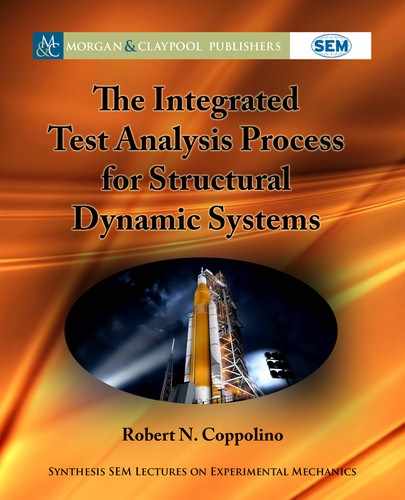4.2. PART2: FREQUENCYRESPONSE FUNCTION ESTIMATES FROM MEASUREDDATA 79
Coherent output autospectra and cumulative coherence function pairs are therefore defined
as follows:
.
G
YY
/
1
D
ˇ
ˇ
H
YZ
1
ˇ
ˇ
2
G
Z
1
Z
1
;
2
Y 1
D
ˇ
ˇ
H
YZ
1
ˇ
ˇ
2
G
Z
1
Z
1
=G
YY
for input x
1
.t/; (4.41)
.
G
YY
/
2
D
ˇ
ˇ
H
YZ
1
ˇ
ˇ
2
G
Z
1
Z
1
C
ˇ
ˇ
H
YZ
2
ˇ
ˇ
2
G
Z
2
Z
2
;
2
Y 2
D
ˇ
ˇ
H
YZ
1
ˇ
ˇ
2
G
Z
1
Z
1
C
ˇ
ˇ
H
YZ
2
ˇ
ˇ
2
G
Z
2
Z
2
=G
YY
for inputs x
1
.t/ C x
2
.t/; (4.42)
.
G
YY
/
K
D
ˇ
ˇ
H
YZ
1
ˇ
ˇ
2
G
Z
1
Z
1
C
ˇ
ˇ
H
YZ
2
ˇ
ˇ
2
G
Z
2
Z
2
C C
ˇ
ˇ
H
YZ
N
ˇ
ˇ
2
G
Z
K
Z
K
;
2
YK
D
ˇ
ˇ
H
YZ
1
ˇ
ˇ
2
G
Z
1
Z
1
C
ˇ
ˇ
H
YZ
2
ˇ
ˇ
2
G
Z
2
Z
2
C C
ˇ
ˇ
H
YZ
N
ˇ
ˇ
2
G
Z
K
Z
K
=G
YY
;
for inputs; x
1
.t/ C C x
k
.t/: (4.43)
e cumulative coherence function family has the property
0
2
Y 1
2
Y 2
: : :
2
YK
1: (4.44)
When graphically displayed as a function of frequency, the coherence function family ap-
pears as a waterfall plot series that clearly indicates the relative contributions of the accumulated
excitation sources. e benefits of such a display will be demonstrated in a series of illustrative
examples.
Finally, it is noted that MI/MO analysis represents a simple extension to MI/SO analysis.
4.2.4 ILLUSTRATIVE EXAMPLE: ISPE MODAL TEST
e ISPE test article was excited with broad band random excitation forces at four separate
locations, and MI/MO correlation and spectral analysis was preformed employing 8192 length
windows with 50% overlap processing. Cumulative coherences for all 265 TAM response chan-
nels plus 4 drive point response channels were computed. MI/MO plots associated with all 4
excitation forces and 4 drive point responses are detailed in Figure 4.8.
e plots in Figure 4.8 are arranged in a 4 4 matrix “plot map.” For example, the plots
in the (2,3) position correspond to excitation 2, drive point response 3. Each plot “i; j ” entry
includes the cumulative coherence (top), FRF phase angle (middle), and FRF magnitude (bot-
tom). An important feature of the plot matrix is FRF “reciprocity” (e.g., the “i; j ” component
is consistent with the “j; i” component, with regard to both magnitude and phase of the FRF).
Greater detail can be discerned from the plot group for the “1, 1” component shown in Fig-
ure 4.9. Of particular interest is the (top) cumulative coherence plot, which (a) indicates the
successive contributions of the first three excitations (to drive point 1 response autospectum)
that are substantially below unity and (b) indicates the significant role of the fourth excitation
producing near unit cumulative coherence.

80 4. MEASURED DATA ANALYSIS
Figure 4.8: Representative ISPE MI/MO FRF and cumulative coherence plots.
File: ISPETESTDFRFs…MI/MO: Navg=16, df=0.025, Input(1)=2302104X-, Output(1)=2302104X+ 21-Sep-2019 3:54 PM
1
0.5
0
200
0
-200
CoherencePhase
10
-1
10
-2
10
-3
10
-4
Magnitude
15 20 25 30 35 40 45 50
15 20 25 30 35 40 45 50
Hz
Hz
15 20 25 30 35 40 45 50
Hz
Figure 4.9: ISPE MI/MO FRF and cumulative coherence plots for excitation 1, drive point
response 1.
..................Content has been hidden....................
You can't read the all page of ebook, please click here login for view all page.
